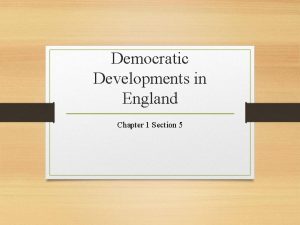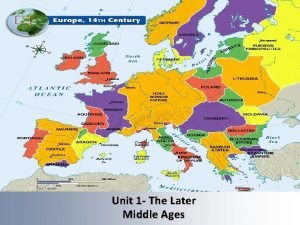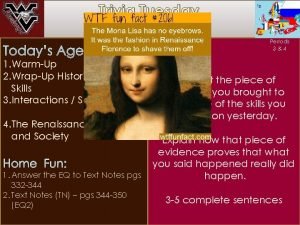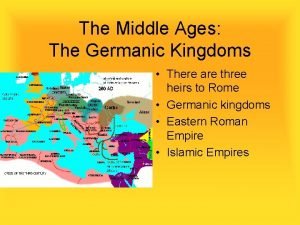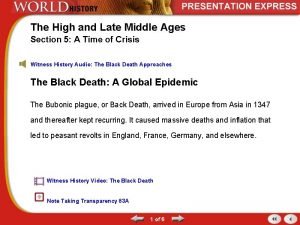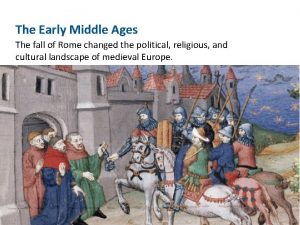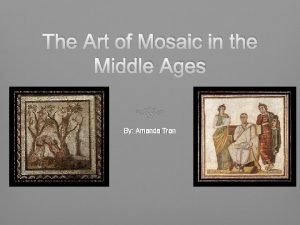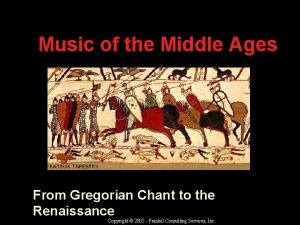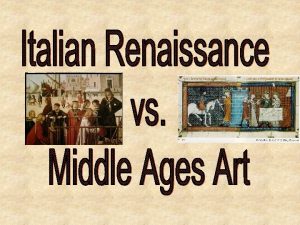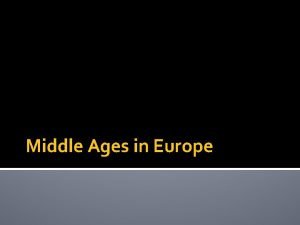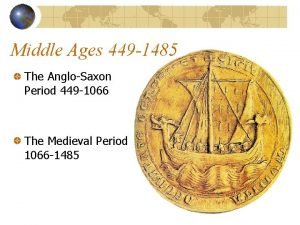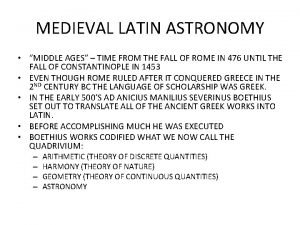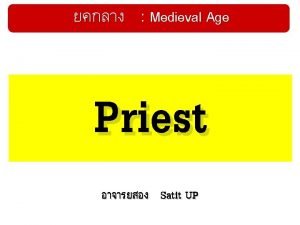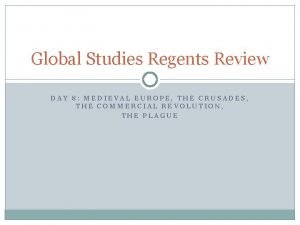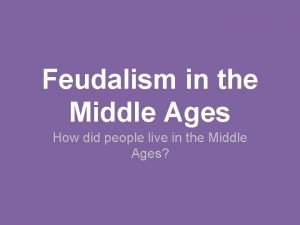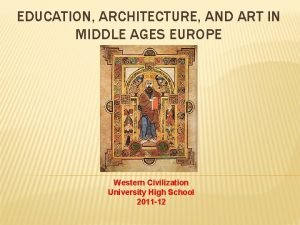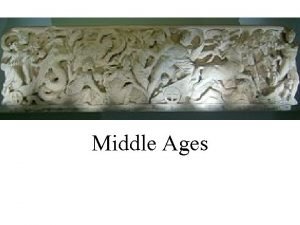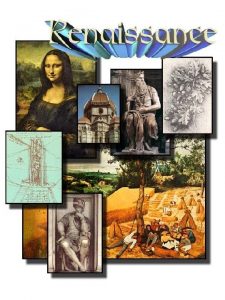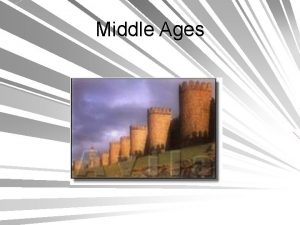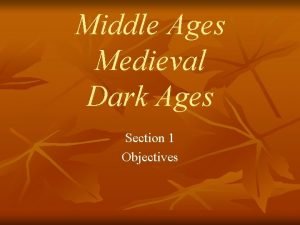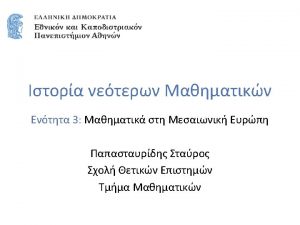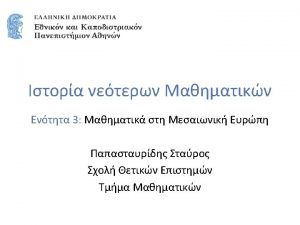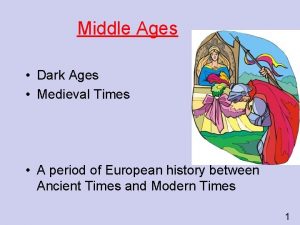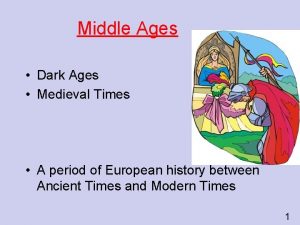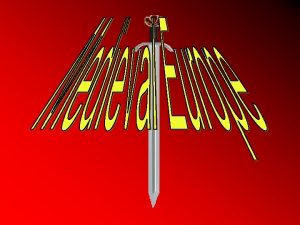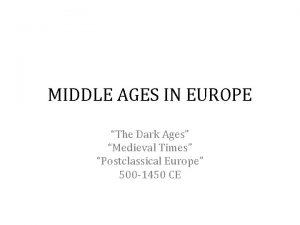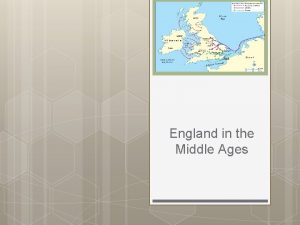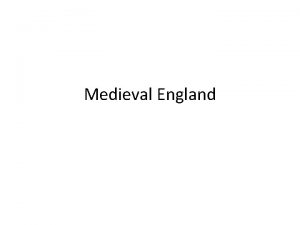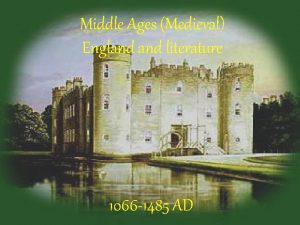Medieval England Medieval meaning the Middle Ages or




















- Slides: 20

Medieval England Medieval meaning the Middle Ages or in Latin medium aevum Approximately from the fall of the Roman Empire 449 A. D. to ca. 1485 A. D.

The Power Of Faith In 596 Pope Gregory I sent missionaries to convert the Anglo Saxons to Christianity n Many people maintained some pagan beliefs n

n n Monks and nuns from Ireland helped spread Christianity throughout England The Catholic Church built hundreds of monasteries not only in Great Britain but all over Europe

Monasteries Most monasteries were communal where everyone shared in the religious and agricultural work. libraries and schools were established inside of the monasteries. Some monasteries were extremely strict and demanded poverty, fasting, absolute obedience, and manual labor.

Monastic Scholars § Monks emphasized the importance of the written word. § Monks painstakingly copied and illuminated manuscripts by hand, often the Bible. § The Venerable Bede was one of the first monks to compose (in Latin) scholarly literature when he wrote The Ecclesiastical History of the English People.

Medieval Pilgrimages were a way to express religious devotion. Ø Pilgrimages were journeys to sacred sites. Ø Many religious pilgrims would go as far as Jerusalem, Rome, and Santiago de Compostela in Spain. Ø For English Pilgrims, one of the most popular sites was Canterbury Cathedral. Ø

Canterbury Cathedral In 1170, Archbishop Thomas a Becket had been slain in the Cathedral by four knights Ø King Henry II may have influenced the murder Ø After Becket’s death he became a religious martyr. Religious pilgrims often traveled to Canterbury to seek blessings Ø The murder of Thomas a Becket.

Religious Drama – Mystery and Morality In the Middle Ages few people could Plays n n n read. The church used sermons, stainedglass windows, frescoes (in Italy), and popular religious plays to teach religion. Plays were initially performed in churches, but later moved to town squares. Often the plays began at the creation of the world and ended with the last judgment. They were known as mystery plays. The actors were commoners from trade “mystery” guilds.


The World of Romance n n The Knight – a central part of the feudal aristocracy Devoted to their lords Trained as warriors Tournaments let them practice their fighting skills

Chivalry and Courtly Love The ideal of civilized behavior, or chivalry, gradually took hold n The code of chivalry encouraged knights to be honorable, generous, brave, skillful in battle, respectful to women, and protective of widows and orphans. n

Courtly Love n n n As the code of chivalry civilized the behavior of knights, the status of women became elevated Courtly love was shared between a knight and a married noblewoman Marriage was often a financial arrangement, and courtly love between a noblewoman and a knight introduced passion into the lives of women. Courtly love was not necessarily sexual.


The Rise of Romance n By 1100, romance became the most popular literary genre in medieval England. n The romance celebrated knights and chivalry n 1300’s – Sir Gawain and the Green Knight was written n 1470 Arthurian Legends – The Death of Arthur/Le Morte d’ Arthur by Sir Thomas Malory King Arthur

Marriage Divorce was forbidden by church law Annulment was allowed on grounds of consanguinity, adultery, or baseborn ancestry, or if the girl was under 12 and the boy under 14 The Medieval age of consent was 7 Simple desertion was common Marital relations usually began before marriage since the engagement was a “contract” between families Wealthy or middle class girls usually had a dowry that consisted of land, etc. Peasant girls often married without a dowry.

NOBLE WOMEN

More on Marriage On the wedding day, a girl wore her best clothes and with her fiancé led a procession to the church door. The couple was married there. The party often lasted hours, days, or even weeks. If you were a peasant, none of this might exist. Peasant women had to help their husbands with all their husband’s labors as well as childrearing and childcare. The wealthy and middle class were expected to manage the entire household and its staff and when the husband was gone, she was expected to manage all of her husband’s business

Women and Births took place at home with midwives Childbirth was very dangerous Baptism was for the middle and upper-class and babies were baptized the day they were born. The church considered the mother “impure” so she could not attend the baptism. She had to go through a “churching” ceremony to restore her purity. Midwives baptized peasant infants

Childhood Infant mortality rates were high Childhood was risky, early death was common Childhood games were often dangerous and could result in death Peasant girls helped their mothers and also worked in the fields during harvest Middle-class girls could apprentice with a woman or a man and learn a trade Upper-class girls were always preparing for marriage

Life Expectancy The average life expectancy of women was 24 Even men could not expect to live much longer Most people died before the age of 30 A Medieval woman at 30 looked like a modern day woman at 60 A dying woman received extreme unction (the last of the seven Christian sacraments) If she lived, she was expected to lead a life like a nun’s: poor, chaste, and penitent
 Dark ages vs middle ages
Dark ages vs middle ages Renaissance vs medieval art
Renaissance vs medieval art How did parliament emerged victorious in medieval england
How did parliament emerged victorious in medieval england European middle ages map
European middle ages map Middle ages renaissance
Middle ages renaissance Germanic kingdoms
Germanic kingdoms French period floral design
French period floral design The high and late middle ages section 5 quiz
The high and late middle ages section 5 quiz Early middle ages
Early middle ages Mosaic middle ages
Mosaic middle ages Late middle ages timeline
Late middle ages timeline Gregorian chant middle ages
Gregorian chant middle ages Dark ages vs renaissance
Dark ages vs renaissance Manorialism def
Manorialism def A metaphorical phrase used to replace a concrete noun
A metaphorical phrase used to replace a concrete noun Astronomy in medieval times
Astronomy in medieval times Clergy ranks
Clergy ranks Middle ages jeopardy
Middle ages jeopardy What were two indirect results of the crusades
What were two indirect results of the crusades Feudal system in the middle ages
Feudal system in the middle ages Education in middle ages
Education in middle ages


